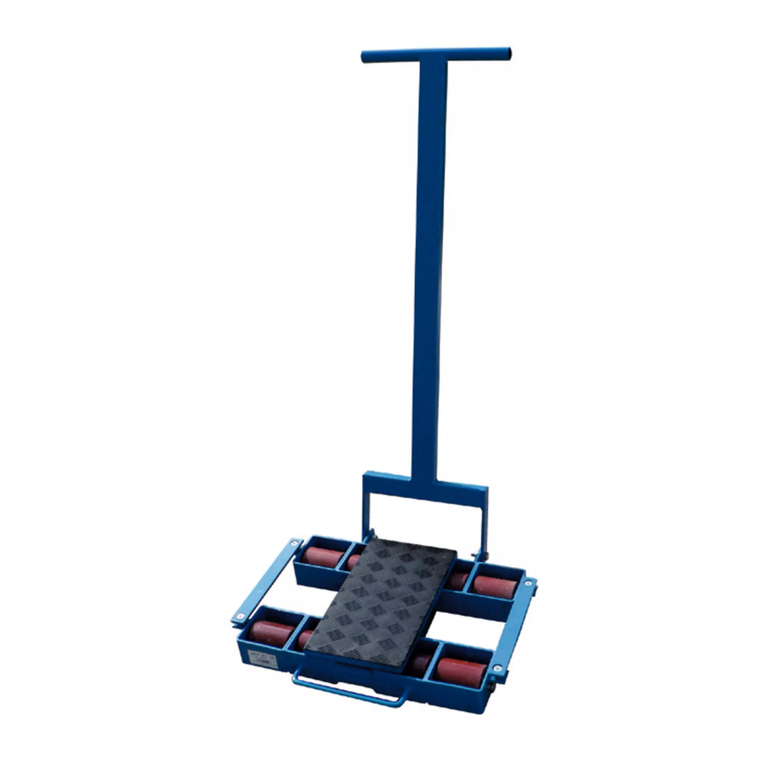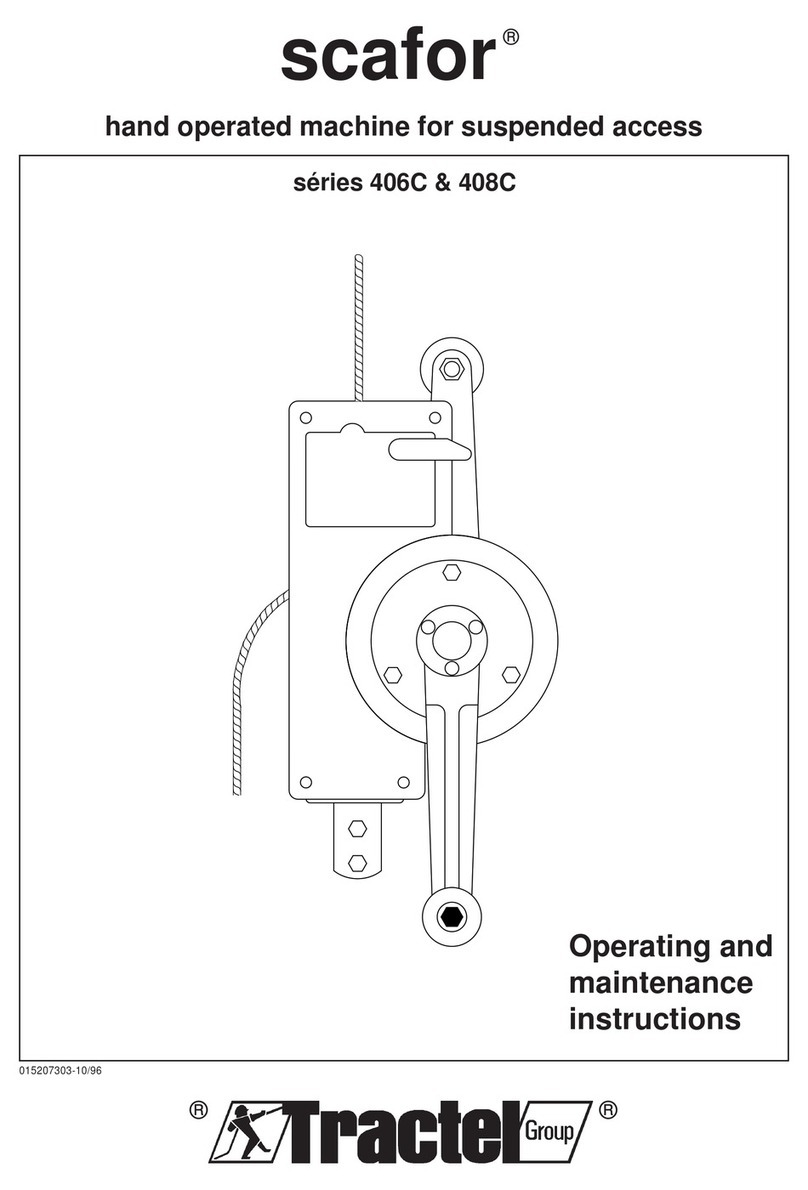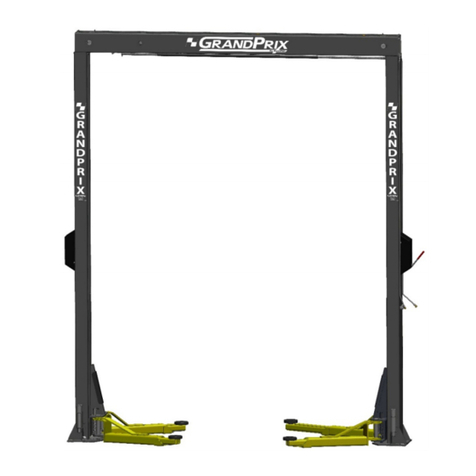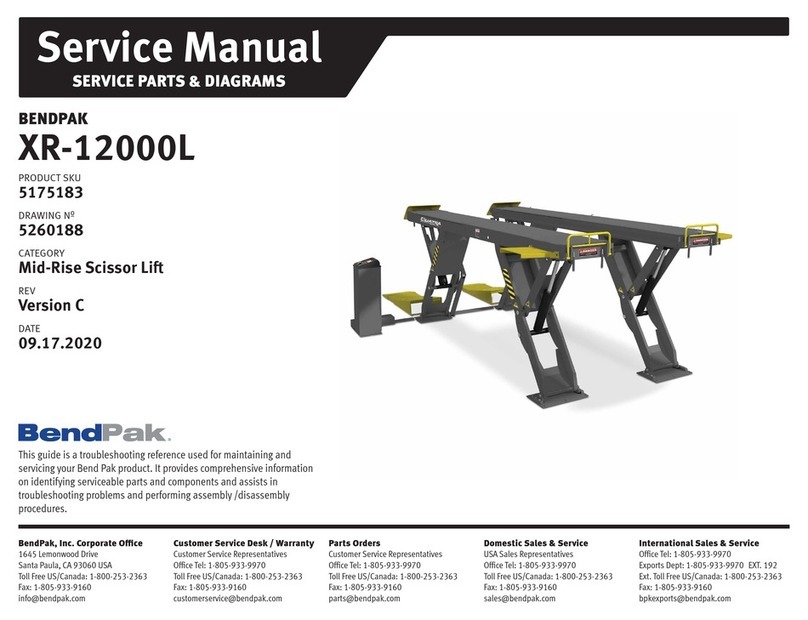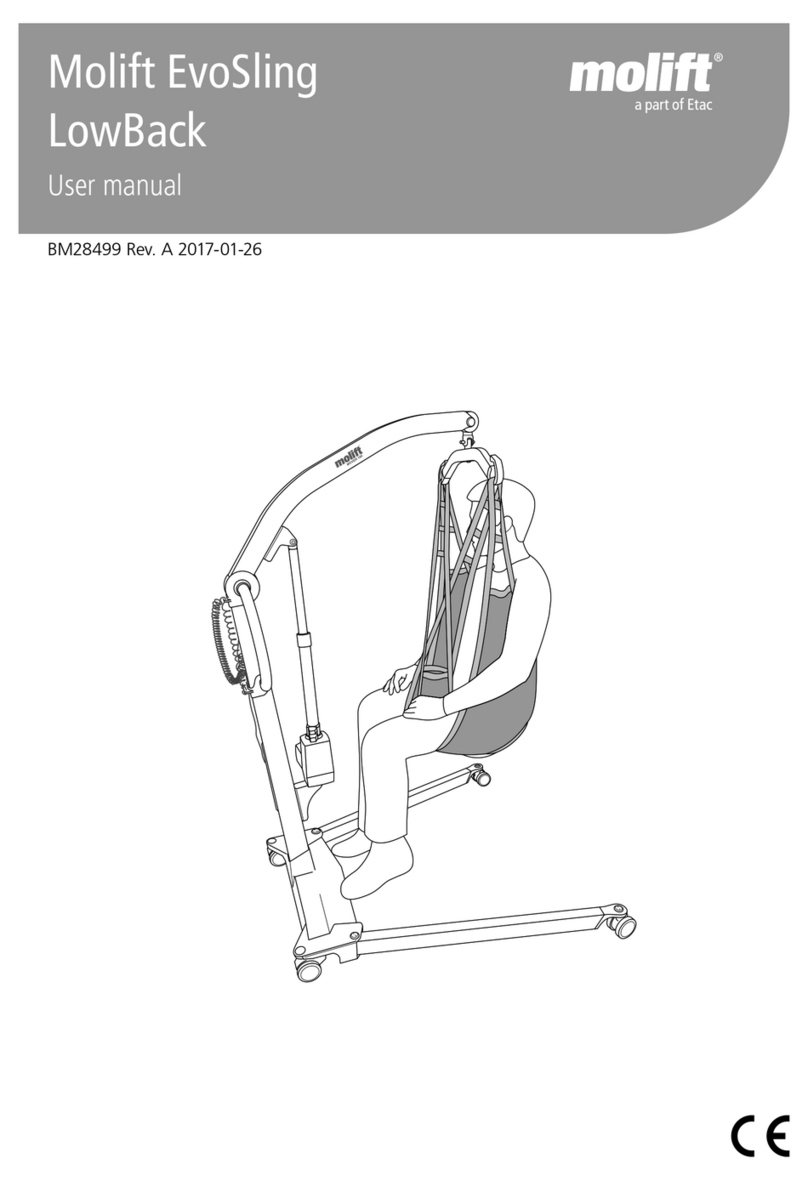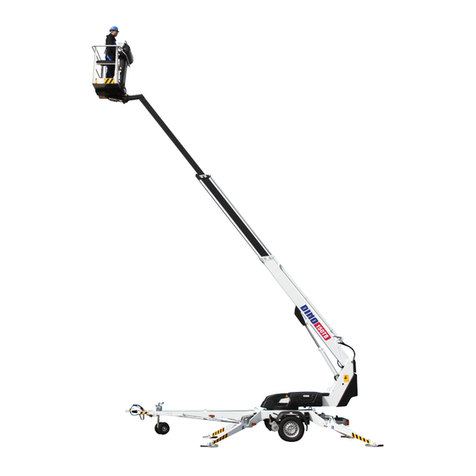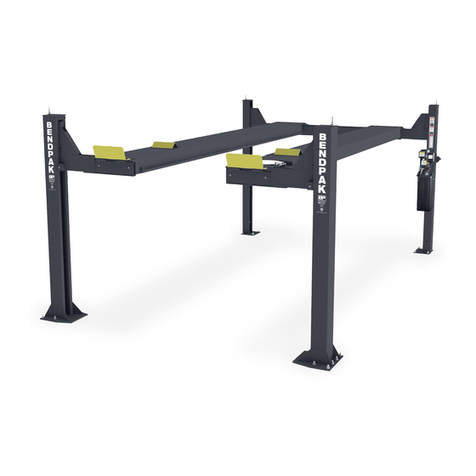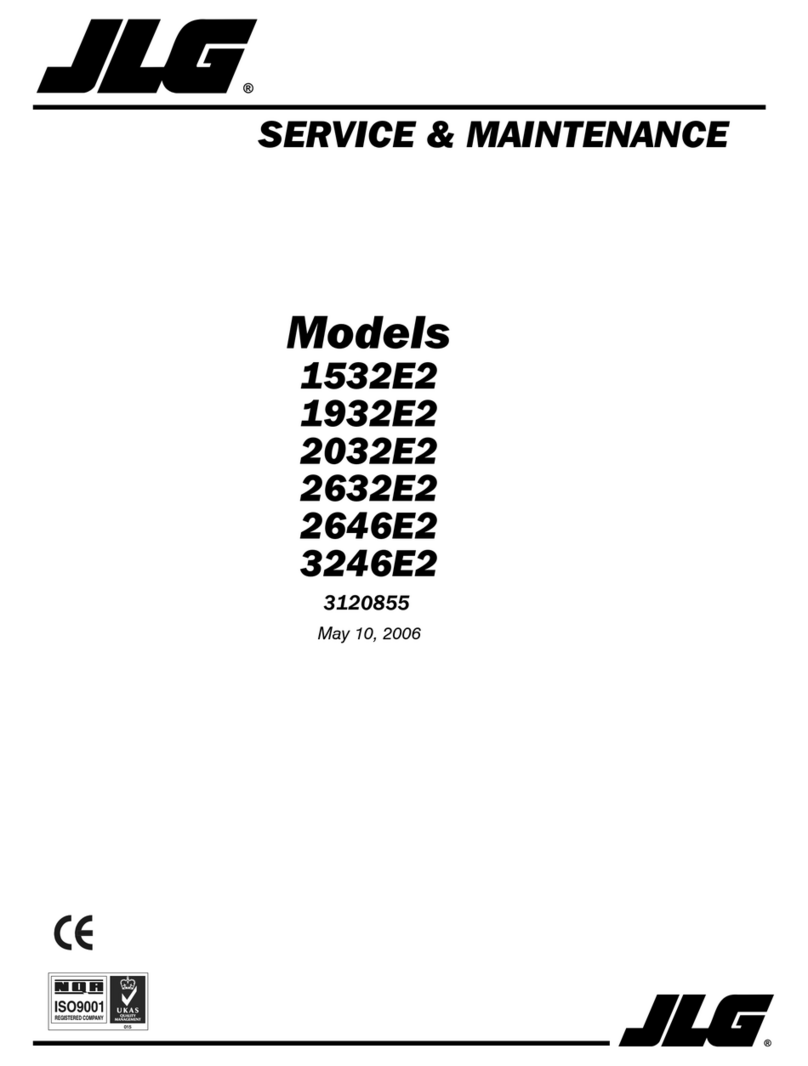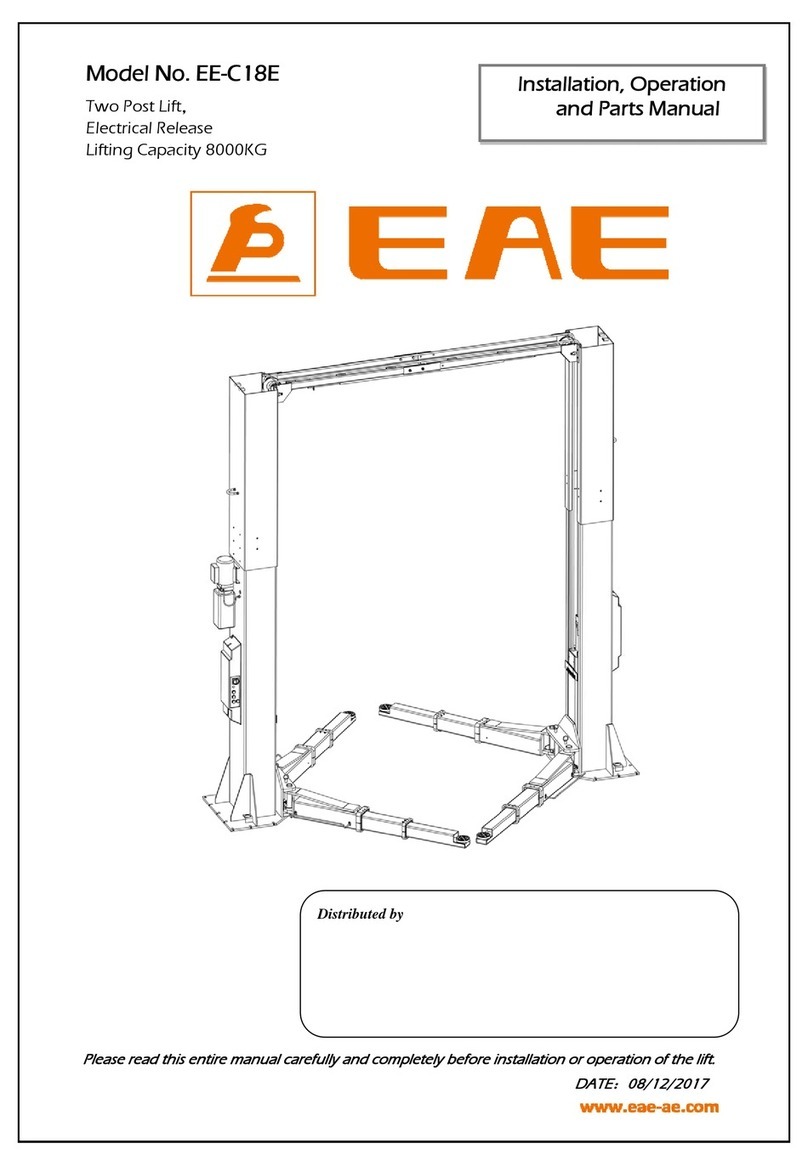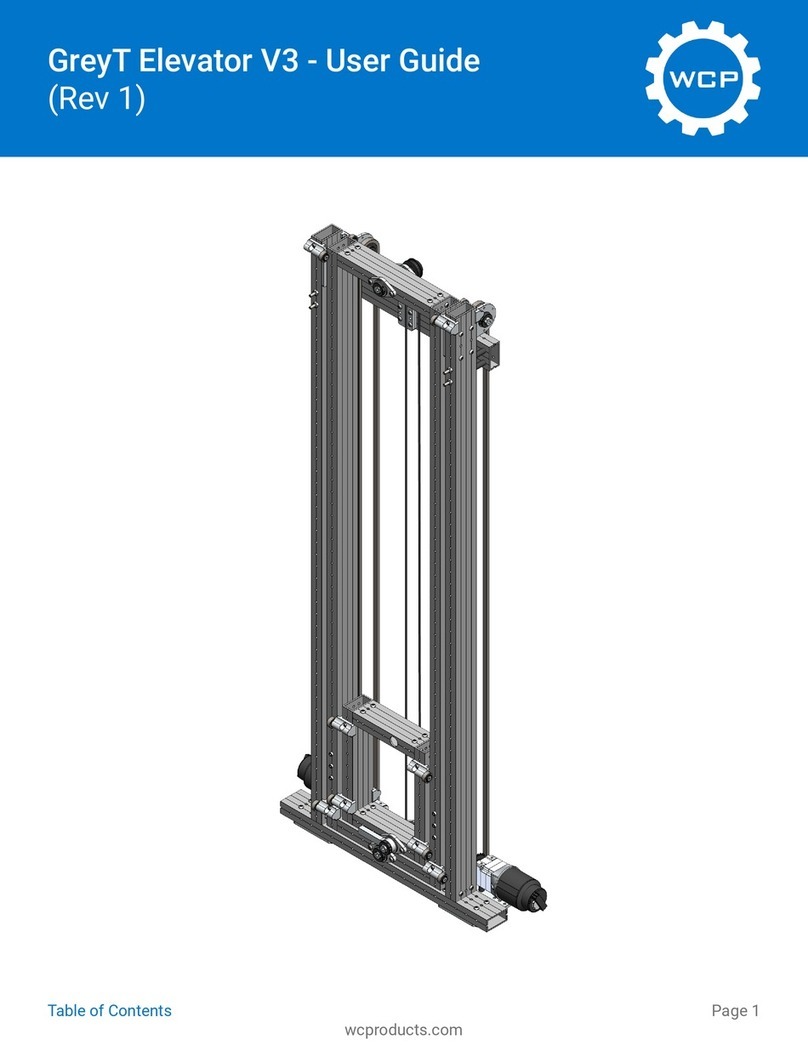Tractel Group jockey User manual

jockey™& J5
treuils à mâchoires
lifting and pulling machines
hijs-en trekapparaat
Handbetriebene Mehrzweck-Seilzüge
Français
English
Nederlands
Deutsch
DE
Instructions d’emploi
et d’entretien
Traduction de notice originale
Operation and maintenance
manual
Original manual
FR
GB
Handleiding voor gebruik
en onderhoud
Vertaling van de oorspronkelijke
handleiding
Gebrauchs- und Wartungsanleitung
Übersetzung der Originalanleitung
NL
2006/42/CE
1

SOMMAIRE Page
Consignes prioritaires 3
Spécifications 4
1. Présentation et description 4
2. Schémas de montage 4
3. Mise en service 5
4. Débrayage et embrayage 5
5. Amarrage 6
6. Manœuvre 6
7. Mise hors service et stockage 6
8. Dispositifs de sécurité 6
9. Câble 7
10. Entretien de l'appareil 7
11. Contre-indications d'emploi 7
12. Anomalies de fonctionnement 8
13. Vérifications réglementaires 8
ILLUSTRATIONS A, B
Afin d'assurer l'amélioration constante de ses produits,
TRACTEL
®
S.A.S. se réserve d'apporter toute modifica-
tion jugée utile, aux matériels décrits dans la présente
notice.
Les sociétés du Groupe TRACTEL
®
et leurs revendeurs
agréés vous fourniront sur demande leur documenta-
tion concernant la gamme des autres produits
TRACTEL
®
: appareils de levage et de traction, matériel
d'accès de chantier et de façade, dispositifs de sécuri-
té, indicateurs de charge électroniques, accessoires
tels que poulies, crochets, élingues, ancrages, etc.
Le réseau TRACTEL
®
peut vous fournir un service
d'après-vente et d'entretien périodique.
1. Crochet / broche d'amarrage
2. Levier de marche avant
3. Levier de marche arrière
4. Poignée de débrayage
5. Poussoirs latéraux
6. Introduction du câble
7. Câble de traction
8. Manche de manoeuvre
9. Elingue d’amarrage
FR
2
8
6
7
9
142
AB
3
8
6
7
9
14
2
3
5

1. Avant d’installer et d’utiliser cet appareil, il est indis-
pensable, pour sa sécurité d’emploi et son efficacité,
de prendre connaissance de la présente notice et de
se conformer à ses prescriptions. Un exemplaire de
cette notice doit être conservé à disposition de tout
opérateur. Des exemplaires supplémentaires peuvent
être fournis sur demande.
2. Ne pas utiliser cet appareil si l’une des plaques fixées
sur l’appareil, ou si l’une des inscriptions y figurant,
comme indiqué à la fin du présent manuel, n’est plus
présente ou lisible. Des plaques identiques peuvent
être fournies sur demande qui doivent être fixées
avant de continuer l’utilisation de l’appareil.
3. Assurez-vous que toute personne à qui vous confiez
l’utilisation de cet appareil en connaît le maniement et
est apte à assumer les exigences de sécurité que ce
maniement exige pour l’emploi concerné. La présen-
te notice doit être mise à sa disposition
4. La mise en oeuvre de cet appareil doit être conforme
à la réglementation et aux normes de sécurité appli-
cables concernant l’installation, l’utilisation, la main-
tenance et le contrôle des appareils de levage de
matériel.
5. Pour tout usage professionnel, cet appareil, doit être
placé sous la responsabilité d’une personne connais-
sant la réglementation applicable, et ayant autorité
pour en assurer l’application si elle n’en est pas l’opé-
rateur.
6. Toute personne utilisant cet appareil pour la première
fois doit vérifier, hors risque, avant d’y appliquer la
charge, et sur une faible hauteur de levage, qu’elle en
a compris toutes les conditions de sécurité et d’effi-
cacité de son maniement.
7. La mise en place et la mise en fonctionnement de cet
appareil doivent être effectuées dans des conditions
assurant la sécurité de l’installateur conformément à
la réglementation applicable à sa catégorie.
8. Avant chaque utilisation de l’appareil, vérifier qu’il est
en bon état apparent, ainsi que les accessoires utili-
sés avec l’appareil.
9. Tractel®exclut sa responsabilité pour le fonctionne-
ment de cet appareil dans une configuration de mon-
tage non décrite dans la présente notice.
10. L’appareil doit être suspendu verticalement à un point
d’amarrage et à une structure suffisamment résis-
tants pour supporter la charge maximum d’utilisation
indiquée sur la présente notice. En cas d’utilisation
de plusieurs appareils, la résistance de la structure
doit être fonction du nombre d’appareils, suivant leur
charge maximale d’utilisation.
11. Toute modification de l’appareil hors du contrôle de
Tractel®, ou suppression de pièce en faisant partie
exonèrent Tractel®de sa responsabilité.
12. Tractel®ne garantit le fonctionnement de l’appareil
que s’il est équipé d’un câble Tractel®d’origine, sui-
vant les spécifications indiquées dans le présent
manuel
13. Toute opération de démontage de cet appareil non
décrite dans cette notice, ou toute réparation effec-
tuée hors du contrôle de Tractel®exonèrent Tractel®
de sa responsabilité, spécialement en cas de rempla-
cement de pièces d’origine par des pièces d’une
autre provenance.
14. Toute intervention sur le câble pour le modifier ou le
réparer en dehors du contrôle de Tractel®exclut la
responsabilité de Tractel®pour les suites de cette
intervention.
15. Cet appareil ne doit jamais être utilisé pour des opé-
rations autres que celles décrites dans cette notice.
Il ne doit jamais être utilisé pour une charge supé-
rieure à la charge maximale d’utilisation indiquée sur
l’appareil. Il ne doit jamais être utilisé en atmosphère
explosive.
16. Il est interdit d’utiliser cet appareil pour le levage ou
le déplacement de personnes.
17. Cet appareil manuel ne doit jamais être motorisé.
18. Lorsqu’une charge doit être soulevée par plusieurs
appareils, l’installation de ceux-ci doit être précédée
d’une étude technique par un technicien compétent,
puis conduite conformément à cette étude, notam-
ment pour assurer la répartition constante de la char-
ge dans des conditions convenables. Tractel®exclut
toute responsabilité pour le cas où l’appareil Tractel®
serait utilisé en combinaison avec d’autres appareils
de levage d’autre origine.
19. Ne jamais stationner ou circuler sous la charge.
Signaliser et interdire l’accès à la zone située sous la
charge.
20. Le contrôle permanent du bon état apparent de l’ap-
pareil et son bon entretien font partie des mesures
nécessaires à sa sécurité d’emploi. L’appareil doit
être vérifié périodiquement par un réparateur agréé
Tractel®comme indiqué dans cette notice.
21. Le bon état du câble est une condition essentielle de
sécurité et de bon fonctionnement de l’appareil. Le
contrôle du bon état du câble doit être effectué à
chaque utilisation comme indiqué au chapitre
“câble”. Tout câble présentant des signes de détério-
ration doit être mis au rebut définitivement.
22. Quand l’appareil n’est pas utilisé, il doit être placé
hors d’atteinte de personnes non autorisées à l’utili-
ser.
23. L’utilisateur doit s’assurer en cours d’utilisation que
le câble est constamment tendu par la charge, et par-
ticulièrement que celle-ci n’est pas neutralisée tem-
porairement par un obstacle en descente, ce qui peut
entraîner un risque de rupture du câble lorsque la
charge se libère de son obstacle.
24. En cas d’arrêt définitif d’utilisation, mettre l’appareil
au rebut dans des conditions interdisant son utilisa-
tion. Respecter la réglementation sur la protection de
l’environnement.
IMPORTANT : Pour tout usage professionnel, spécia-
lement si vous devez confier cet appareil à un person-
nel salarié ou assimilé, conformez vous à la réglemen-
tation du travail applicable au montage, à la mainte-
nance et à l’utilisation de ce matériel, notamment
concernant les vérifications exigées : vérification à la
première mise en service par l’utilisateur, vérifications
périodiques et après démontage ou réparation.
CONSIGNES PRIORITAIRES
FR
3

1. PRÉSENTATION ET DESCRIPTION
DE L’APPAREIL
Le JOCKEY™est un appareil portatif de traction et de
levage, à câble passant, qui assure toutes les fonc-
tions d’un treuil ou d’un palan manuel dans les condi-
tions d’utilisation les plus variées avec des avantages
exclusifs.
Son originalité réside dans le principe de traction du
câble. Celui-ci, au lieu de s’enrouler sur un tambour,
comme pour les palans ou treuils classiques, est
entraîné de façon rectiligne par deux pinces à la
manière de deux mains pour le tirer ou pour l’accom-
pagner dans la descente. Le mécanisme est auto-ser-
rant. L’effort est transmis aux leviers de manoeuvre
(marche avant ou marche arrière), par un manche
télescopique amovible.
L’appareil est muni d’un organe d’amarrage : crochet
ou broche suivant les modèles, permettant de le fixer
rapidement à tout point fixe de résistance suffisante.
Les appareils JOCKEY™et JOCKEY™J5 destinés à la
traction et au levage de matériel sont présentés sui-
vant 2 modèles :
– Jockey™capacité 300 kg,
– Jockey™J5 capacité 500 kg.
Modèle Jockey™: une livraison standard se compose
d’un appareil avec son manche de manœuvre, d’un câble
spécial d’une longueur de 10 m équipé d’un crochet avec
linguet de sécurité et de deux élingues d’amarrage, une
de 1 m et une de 2 m, le tout conditionné dans une mal-
lette de transport réutilisable. (toutes autres longueurs de
câble et d’élingue sont disponibles sur commandes).
Modèle Jockey™J5 : le jockey™J5 est proposé sui-
vant deux présentations standards composées d’un
appareil avec son manche de manœuvre et avec :
- soit un câble spécial d’une longueur de 10 m équipé
d’un crochet avec linguet de sécurité, deux élingues
d’amarrage de 2 m ;
- soit un câble spécial d’une longueur de 10 m équi-
pé d’un crochet avec linguet de sécurité, deux
élingues d’amarrage de 2 m, et une poulie de mou-
flage permettant de doubler la capacité de charge
de l’appareil.
Le présent livret et une carte de garantie sont joints à
chaque appareil, ainsi que la déclaration de conformi-
té CE.
IMPORTANT : Les câbles TIRFOR®sont spé-
cialement conçus pour être utilisés avec les appa-
reils JOCKEY™conformément à la conception par-
ticulière de ces appareils. TRACTEL®S.A.S. ne
peut garantir la sécurité de fonctionnement de
ceux-ci avec des câbles autres que des câbles
TIRFOR®.
2. SCHÉMAS DE MONTAGE
Les cas de montage possibles sont indiqués par les
FR
4
* Y compris les terminaisons du câble.
** Avance du câble pour la charge maximale d'utilisation par course complète aller et retour du levier.
SPECIFICATIONS
MODELE
Charge maximale d'utilisation
Poids
appareil
manche de manœuvre
câble standard 10m/20m
Poids total équipement standard
Dimensions de l'appareil
longueur
hauteur
épaisseur
manche de manœuvre
Câble original JOCKEY
diamètre
charge de rupture garantie*
poids au mètre
Avance du câble (M. av./M. ar.)**
kg
kg
kg
kg
kg
mm
mm
mm
mm
mm
daN
kg
mm
300
1,75
0,27
1,0 / -
3,0 / -
320
200
40
400
4,72
1800
0,09
28 / 32
500
3,75
0,35
1,9 / 3,7
6,0 / 7,8
370
215
55
500
6,5
3100
0,185
24 / 34
Jockey Jockey J5

figures 2.1, 2.2, 2.3 et 2.4 page 34. Les figures 4 et 5
page 34 montrent des cas particuliers (montage inter-
dit et montage autorisé).
L’appareil peut être amarré à un point fixe, le câble se
déplaçant à travers l’appareil (Fig. 2.1, 2.2, 2.3 p. 34),
soit se déplacer le long du câble, avec sa charge, le
câble étant amarré à un point fixe (Fig. 2.4 p. 34).
Dans le cas 2.2 page 34, la résistance de la poulie et
de sa fixation doit être supérieure à deux fois la charge.
N.B. : Quel que soit le schéma de montage, et si l’ap-
pareil est amarré directement à un point fixe, il doit
pouvoir s’aligner sans contrainte sur la direction de la
charge ou de l’effort. A cette fin, il est recommandé
d’interposer une élingue de résistance appropriée
entre le point d’amarrage et l’appareil (Fig. 3 p. 34).
AVERTISSEMENT : Tout montage nécessitant
un calcul des forces appliquées doit être contrôlé par
un technicien compétent, spécialement concernant la
résistance nécessaire des points fixes utilisés.
Dans des travaux tels que le guidage d’une chute
d’arbre, l’opérateur doit se mettre à l’écart de la zone
dangereuse en faisant passer le câble dans une ou
plusieurs poulies de renvoi.
La capacité de l’appareil peut être augmentée considé-
rablement pour un même effort de l’opérateur par l’em-
ploi de poulies de mouflage. (Voir exemples de sché-
mas fig. 6.1 et 6.2 p. 34). L’augmentation de capacité
indiquée est réduite suivant le rendement des poulies.
Le diamètre des poulies utilisées doit être égal à 18
fois au moins le diamètre du câble. (Vérifier la régle-
mentation applicable le cas échéant).
Pour tout montage autre que ceux décrits sur la
présente notice, consulter TRACTEL®S.A.S. ou un
spécialiste compétent avant d’opérer.
3. MISE EN SERVICE
N.B. Il est recommandé de protéger les mains par des
gants de travail pour manipuler le câble et les
élingues.
3.1. Jockey™(carter en plastique vert).
1. Dérouler le câble en évitant de le tordre et de for-
mer des boucles.
2. Débrayer le mécanisme de l’appareil (voir chapitre
“Débrayage/Embrayage”).
3. Introduire l’extrémité libre du câble dans l’entrée E
jusqu’à ce qu’il ressorte par la sortie de câble S
(fig. 7.2).
4. Engager dans le crochet de l’appareil les deux
boucles de l’élingue située autour du point fixe
(voir chapitre “Amarrage”).
5. Régler à la main la longueur utile du câble.
6. Embrayer le mécanisme en manœuvrant le bou-
ton de débrayage (voir chapitre “Débrayage /
Embrayage”).
7. Introduire alors le manche de manœuvre sur le
levier de marche avant et par un mouvement de
va-et-vient, commencer la traction ou le levage. Le
levier de marche arrière vous permet de relâcher
la tension ou de descendre la charge.
A l’issue de ces opérations, l’appareil est prêt à opé-
rer, sous réserve que la charge soit correctement
amarrée à l’appareil ou au câble (voir chapitre
“Amarrage” et “Schémas de montage”).
Si le câble est amarré à un point haut, élevé, on pro-
cède à son amarrage avant les autres opérations.
3.2. Jockey™J5 (carter aluminium)
1. Dérouler le câble soigneusement en évitant toute
boucle.
2. Débrayer le mécanisme de l’appareil (voir chapitre
“Débrayage / Embrayage”).
3. Introduire l’extrémité libre du câble dans l’entrée E
jusqu’à ce qu’il ressorte par la sortie de câble S
(fig. 8.2).
4. Engager dans le crochet de l’appareil les deux
boucles de l’élingue située autour du point fixe
(voir chapitre “Amarrage”).
5. Régler à la main la longueur utile du câble.
6. Embrayer le mécanisme en manœuvrant le bou-
ton de débrayage (voir chapitre “Débrayage/
Embrayage”).
7. Introduire alors le manche de manœuvre sur le
levier de marche avant et par un mouvement de
va-et-vient, commencer la traction ou le levage. Le
levier de marche arrière vous permet de relâcher
la tension ou de descendre la charge.
Si le câble est amarré à un point haut, élevé, on pro-
cédera à son amarrage avant les autres opérations.
A l’issue de ces opérations, l’appareil est prêt à opé-
rer, sous réserve que la charge soit correctement
amarrée à l’appareil ou au câble (voir chapitre
“Amarrage” et “Schémas de montage”).
Si le câble est amarré à un point haut, élevé, on pro-
cède à son amarrage avant les autres opérations.
4. DEBRAYAGE ET EMBRAYAGE
Chaque appareil est muni d’un bouton (4) permettant
dedébrayer le mécanisme de serrage par une
manœuvre qui ne doit être opérée que sans charge.
Deux positions sont donc possibles pour la poignée
FR
5

de débrayage : débrayée ou embrayée.
N.B. Il est recommandé de placer la poignée de
débrayage en position embrayée lorsqu’on n’utilise
pas l’appareil. Ceci impose de débrayer l’appareil
avant d’y introduire le câble.
4.1. Jockey™
Débrayage : Libérer la manette de débrayage, en la
poussant légèrement vers le haut, contre lecarter,
puis en la tirant vers l’extérieur (fig. 7.1).
Embrayage : Pousser à fond la manette avec un
léger mouvement vers le bas (fig. 7.2).
4.2. Jockey™J5
Débrayage : Libérer la manette de débrayage en la
poussant contre l’appareil, puis en pressant sur les
deux poussoirs latéraux pour la tirer vers l’extérieur
(fig. 8.1).
Embrayage : Pousser la manette de débrayage jus-
qu’à son enclenchement. Le Jockey™J5 est ainsi prêt
à fonctionner (fig. 8.2).
5. AMARRAGE
Un défaut d’amarrage peut entraîner un risque
d’accident grave. L'utilisateur doit toujours vérifier,
avant d'opérer, que le ou les points d'amarrage de
l'appareil ou du câble présentent une résistance
suffisante à la force à exercer (levage ou traction).
Il est recommandé d’amarrer les appareils JOCKEY™
en les reliant au point fixe ou à la charge au moyen
d’une élingue de capacité appropriée. Il est interdit
d’utiliser le câble de l’appareil comme élingue en le
passant autour d’un objet pour le reprendre par son
crochet (Fig. 9-1 : cas interdit; 9-2 : usage normal
p.35).
Avertissement : Il est indispensable pour la
sécurité d’emploi de l’appareil, de s’assurer, avant la
mise en charge, que les organes d’amarrage, crochet
ou broche, sont correctement verrouillés (linguet
fermé pour le crochet (Fig. 12 p. 35).
6. MANŒUVRE
La manœuvre du JOCKEY™est d’une grande simpli-
cité et s’effectue en manœuvrant le manche suivant
un mouvement de va-et-vient dont l’amplitude est
variable suivant la commodité de l’opérateur.
Tout arrêt de la manœuvre entraîne l’auto-serrage
automatique des deux pinces sur le câble, la charge
étant répartie de façon égale, en prise permanente,
sur celles-ci.
Les mouvements des leviers de marche avant et de
marche arrière sont à double effet, la charge se dépla-
çant à chaque course de levier dans l’un et l’autre
sens de mouvement du manche.
7. MISE HORS SERVICE ET STOCKAGE
7.1. Jockey™
La manœuvre terminée pour libérer le Jockey™et sor-
tir son câble, actionner si besoin le levier de marche
arrière pour supprimer toute tension dans le câble.
Décrocher l’élingue. Débrayer l’appareil en procédant
ainsi :
- Libérer la manette de débrayage en la poussant
contre l’appareil avec un léger mouvement vers le
haut (fig. 7.1).
- Retirer le câble d’une main en tenant de l’autre main
le Jockey™par la manette de débrayage (fig. 10).
- Enrouler soigneusement le câble en évitant toute
boucle.
7.2. Jockey™J5
La manœuvre terminée pour libérer le Jockey™J5 et
sortir son câble, actionner si besoin le levier de marche
arrière pour supprimer toute tension dans le câble.
Décrocher l’élingue. Débrayer l’appareil en procédant
ainsi :
- Pousser à fond la manette de débrayage contre le
carter.
- Tout en maintenant poussée cette manette, presser
sur les deux poussoirs latéraux.
- Relâcher la manette qui doit reculer d’elle-même
(tirer si nécessaire). (fig. 8.1).
- Retirer le câble d’une main en tenant de l’autre main
le J5 par la manette de débrayage (fig. 11).
- Enrouler soigneusement le câble en évitant toute
boucle.
8. DISPOSITIFS DE SECURITE
8.1. Jockey™
N’utiliser que le manche de manœuvre qui vous a été
fourni. Sa longueur a été fixée en fonction des perfor-
mances de l’appareil. Il casse en cas de surcharge.
8.2. Jockey™J5
Le Jockey™J5 possède une sécurité de surcharge par
FR
6

rupture de goupille.
Remplacement de la goupille :
- Dévisser les 5 vis de fixation du carter.
- Oter le carter puis le mécanisme, chasser la goupille
cisaillée avec un chasse-goupille de Ø 5 mm.
Prendre une des deux goupilles de rechange logées
dans le coin du carter, mettre en place la goupille
neuve au marteau.
- Remonter l’appareil.
Avertissement : Il est interdit de remplacer
des goupilles cisaillées par des moyens autres
que des goupilles TRACTEL®de même modèle.
9. CABLE
Il est essentiel, pour garantir la sécurité d’emploi
des appareils JOCKEY™, de les utiliser exclusive-
ment avec des câbles TIRFOR®, conçus spéciale-
ment pour ces appareils.
Une extrémité du câble porte un crochet de sécurité
monté sur une boucle du câble équipée d’une cosse et
sertie dans un manchon métallique (voir Fig. 12 p. 35).
L’autre extrémité du câble est soudée et meulée (voir
Fig. 13 p. 35).
Le bon état du câble est une garantie de sécurité,
au même degré que le bon état de l’appareil. Il est
donc nécessaire de surveiller constamment l’état du
câble, et de nettoyer et graisser celui-ci avec un chif-
fon imbibé d’huile ou de graisse.
Eviter les graisses et huiles contenant du bisulphure
de molybdène ou des additifs graphités.
Examen visuel du câble
Le câble doit être examiné quotidiennement lorsqu’il
est en utilisation afin de détecter les signes de dété-
rioration éventuelle (déformation, rupture de fil :
exemple Fig. 14).
En cas de détérioration apparente, faire vérifier le
câble par une personne compétente. Tout câble dont
l’usure a réduit le diamètre nominal de 10% doit être
éliminé. (Mesurer comme indiqué fig. 15 p. 35).
IMPORTANT : Il est recommandé, spéciale-
ment pour les opérations de levage, de s’assurer que
la longueur du câble est supérieure à la course à uti-
liser. Prévoir un mètre supplémentaire au moins qui
doit toujours dépasser le carter de l'appareil du côté
de l'amarrage.
Pour le levage et la descente de charges sur des
câbles de grande longueur, on empêchera la charge
de tourner afin d’éviter le détoronnage du câble.
Ne jamais laisser un câble tendu porter en frottement
sur un obstacle et n’utiliser que des poulies d’un dia-
mètre adéquat.
Ne pas exposer le câble à une température supérieu-
re à 100° ni à l’agression d’agents mécaniques ou chi-
miques.
Stockage : voir chapitre 7.
10. ENTRETIEN DE L’APPAREIL
L’entretien de l’appareil consiste à le nettoyer, à le hui-
ler et à le faire contrôler périodiquement (au moins
annuellement) par un réparateur agréé TRACTEL®.
Ne jamais utiliser d’huile ni graisse contenant du bisul-
phure de molybdène ou un additif graphité.
Pour nettoyer l’appareil, le plonger entièrement dans
un bain de solvant tel que pétrole, essence, white-spi-
rit, à l’exclusion de l’acétone et dérivés, de trichloré-
thylène et dérivés, puis le secouer pour détacher la
boue et autres corps étrangers. Renverser l’appareil
pour faire sortir la saleté par l’ouverture des leviers.
Egoutter et laisser sécher.
Il est alors indispensable de lubrifier abondam-
ment le mécanisme en versant de l’huile (type SAE
90 120) par les ouvertures du carter. Débrayer aupa-
ravant, l’appareil étant hors charge et manœuvrer les
leviers pour faciliter la pénétration de l’huile dans
toutes les parties du mécanisme.
N.B. : Un excès de lubrification de l’appareil n’est
jamais à craindre.
Tout appareil dont le carter porte des traces de choc ou
de déformation, ou dont le crochetest déformé doit être
retourné à un réparateur agréé du réseau TRACTEL®.
11. CONTRE-INDICATIONS D’EMPLOI
L’utilisation des appareils (JOCKEY™) conformément
aux indications de la présente notice donne toute
garantie de sécurité. Il apparaît utile toutefois de
mettre l’opérateur en garde contre les manipulations
fautives indiquées ci-dessous. Il est interdit :
– d’utiliser pour le levage de personnes les appareils
décrits dans la présente notice,
– de les motoriser,
– d’utiliser les appareils (JOCKEY™) au-delà de leur
capacité nominale,
– de les utiliser pour d’autres opérations que celles
auxquelles ils sont destinés,
– d’essayer de manoeuvrer la poignée de débraya-
ge lorsque l’appareil est en charge,
– d’entraver le libre débattement du levier de
marche arrière, du levier de marche avant ou de la
poignée de débrayage,
– d’actionner simultanément le levier de marche
FR
7

8
13. VERIFICATIONS REGLEMENTAIRES
Toute entreprise confiant un appareil JOCKEY™ou JOCKEY™J5 à un personnel salarié ou assimilé doit
appliquer la réglementation du travail concernant la sécurité.
En France, ces appareils doivent, dans ce cas, recevoir une vérification initiale avant mise en service et des
vérifications périodiques (arrêté du 9 juin 1993).
Vérifiez que les étiquettes sont en place.
Des étiquettes de remplacement seront fournies sur demande.
FR
avant et de marche arrière,
– d’utiliser tout autre moyen de manœuvre que le
manche télescopique d’origine,
– de remplacer les goupilles de sécurité d’origine
par tout autre moyen que des goupilles TIRFOR®
du même modèle,
– de fixer l’appareil par tout autre moyen que son
organe d’amarrage,
– de bloquer l’appareil dans une position fixe ou
gêner son auto-alignement sur la direction de la
charge,
– d’utiliser le câble de l’appareil comme moyen
d’élingage,
– d’appliquer une charge sur le brin du câble sortant
du côté de l’amarrage,
– de donner des coups sur les organes de com-
mande,
– de manœuvrer en marche avant jusqu'à amener le
manchon du crochet de câble au contact du carter.
– de manœuvrer en marche arrière jusqu'à ce que
l'extrémité du câble vienne à proximité du carter.
12. ANOMALIES DE FONCTIONNEMENT
1) Si le levier de marche avant tourne librement
sur
son axe sans entraîner le mécanisme, cela indique
que les goupilles de sécurité se sont cisaillées sous
l’effet d’une surcharge. Il convient de les remplacer
comme indiqué au paragraphe 8.2 (modèle J5).
2) Pompage :
Une insuffisance d’huile dans le mécanisme entraîne
un phénomène (sans danger) appelé “pompage” qui
se produit en marche avant : le câble ou l’appareil
(suivant le montage) monte et descend de quelques
centimètres sans progression. En versant de l’huile
dans le carter on supprime ce phénomène. Au besoin,
manoeuvrer en marche arrière sur un faible parcours
pour faciliter la lubrification des pièces.
3) Secousses :
Une manœuvre saccadée en marche arrière est éga-
lement causée par un manque d’huile. Procéder
comme ci-dessus.
4) Blocage :
Si le câble se trouve bloqué dans l’appareil, générale-
ment par une détérioration de la partie du câble qui s’y
trouve, il faut absolument arrêter la manœuvre.
Reprendre la charge par un autre moyen offrant les
garanties réglementaires de sécurité, et dégager
l’appareil en le débrayant hors charge. Dans le cas
extrême où cela serait impossible, retourner l’appareil
et son câble à un réparateur agréé TRACTEL®.

GB
2
CONTENTS Page
General warning 3
Technical data 4
1.
Introduction and description of equipment
4
2. Rigging arrangements 4
3. Installing the wire rope 5
4. Releasing and closing the jaws 5
5. Anchoring 6
6. Operation 6
7. Releasing the wire rope and storage 6
8. Safety devices 6
9. Wire rope 7
10. Maintenance instructions 7
11. Warnings against hazardous operations 7
12. Troubleshooting 8
13. Health and safety at work 8
PICTURES A, B
Always concerned to improve the quality of its pro-
ducts, the TRACTEL
®
Group reserves the right to modi-
fy the specifications of the equipment described in this
manual.
The companies of the TRACTEL
®
Group and their
agents or distributors will supply on request descriptive
documentation on the full range of TRACTEL
®
products
: lifting and pulling machines, permanent and tempora-
ry access equipment, safety devices, electronic load
indicators, accessories such as pulley blocks, hooks,
slings, ground anchors, etc.
The TRACTEL
®
network is able to supply an after-
sales and regular maintenance service.
1. Hook / anchor pin
2. Forward operating lever
3. Reverse operating lever
4. Rope release lever
5. Side buttons
6. Rope guide
7. Wire rope
8. Operating handle
9. Anchor sling
8
6
7
9
142
AB
3
8
6
7
9
14
2
3
5

GB
3
GENERAL WARNING
1. Before installing and using this unit, to ensure safe, effi-
cient use of the unit, be sure you have read and fully
understood the information and instructions given in
this manual. A copy of this manual should be made avai-
lable to every operator. Extra copies of this manual will
be supplied on request.
2. Do not use the unit if any of the plates mounted on the
unit is missing or if any of the information on the plates,
as indicated at the end of the manual, is no longer legible.
Identical plates will be supplied on request; these must be
secured on the unit before it can be used again.
3. Make sure that all persons operating this unit know per-
fectly how to use it in a safe way, in observance of all
safety at work regulations. This manual must be made
available to all users.
4. This unit must only be used in compliance with all appli-
cable safety regulations and standards concerning ins-
tallation, use, maintenance and inspection of equipment
lifting devices.
5. For all professional applications, the unit must be pla-
ced under the responsibility of a person who is entirely
familiar with the applicable regulations and who has the
authority to ensure the applicable regulations are
applied if this person is not the operator.
6. Any person using the unit for the first time must first
verify that he has fully understood all the safety and cor-
rect operation requirements involved in use of the unit.
The first-time operator must check, under risk-free
conditions, before applying the load and over a limited
lifting height, that he has fully understood how to safely
and efficiently use the unit.
7. The unit must only be installed and set into service
under conditions ensuring the installer’ safety in com-
pliance with the regulations applicable to its category.
8. Each time, before using the unit, inspect the unit for any
visible damage, as well as the accessories used with the
unit.
9. Tractel®declines any responsibility for use of this unit in
a setup configuration not described in this manual.
10. The unit must be suspended vertically to an anchoring
point and a structure having sufficient strength to withs-
tand the maximum utilization load indicated in this manual.
If several units are used, the strength of the structure must
be compatible with the number of lifting units used and
with the maximum utilization load of the units.
11. Tractel®declines any responsibility for the conse-
quences of any changes made to the unit or removal of
parts forming part of the unit.
12. Tractel®will only guaranty operation of the unit provided
it is equipped with an original Tractel®wire rope in accor-
dance with the specifications indicated in this manual.
13. Tractel®declines any responsibility for the conse-
quences resulting from disassembly of the unit in any
way not described in this manual or repairs performed
without Tractel®authorization, especially as concerns
replacement of original parts by parts of another manu-
facturer.
14. Tractel®declines any responsibility for the conse-
quences resulting from any unauthorized changes or
repairs to the wire rope.
15. The unit must never be used for any operations other
than those described in this manual. The unit must
never be used to handle any loads exceeding the maxi-
mum utilization load indicated on the unit. It must never
be used in explosive atmospheres.
16. The unit must never be used for lifting people.
17. The unit is designed for manual operation and must
never be motorized.
18. When a load is to be lifted by several units, a technical
study must first be carried out by a qualified technician
before installation of the units. The installation must
then be carried out in compliance with the study, in par-
ticular to ensure an even distribution of the load under
appropriate conditions. Tractel®declines any responsi-
bility for the consequences resulting from use of a
Tractel®device in combination with other lifting devices
of another manufacturer.
19. Never park or circulate under a load. Access to the area
under the load should be indicated by signs and prohi-
bited.
20. To ensure safe use of the unit, it should be visually ins-
pected and serviced regularly. The unit must be periodi-
cally inspected by a Tractel®-approved repair agent as
indicated in this manual.
21. The wire rope must be in good condition to ensure safe,
correct operation of the unit. Discard any wire rope which
shows any signs of excess wear or damage. The condi-
tion of the wire rope should be checked each time before
using the unit as detailed in the “wire rope” section.
22. When the unit is not being used, it should be stored in a
location inaccessible to persons not authorized to use
the unit.
23. When using the unit, the operator must ensure that the
wire rope remains constantly tensioned by the load, and
more particularly, the operator must ensure that the load
is not temporarily snagged by an obstacle when coming
down as this could result in rupture of the wire rope
when the load is released from its obstacle.
24. If the unit is to be definitively removed from use, make
sure the unit is discarded in a way which will prevent
any possible use of the unit. All environment protection
regulations must be observed.
IMPORTANT : For professional applications, in particular if
the unit is to be operated by an employee, make sure that you
are in compliance with all safety at work regulations gover-
ning installation, maintenance and use of the equipment, and
more specifically as concerns the required inspections : veri-
fication on commissioning by user, periodic inspections, and
inspections subsequent to disassembly or repair operations.

GB
4
1. INTRODUCTION AND DESCRIPTION
OF EQUIPMENT
The JOCKEY™machine is a hand-operated lifting and
pulling machine. It is versatile, portable and multi-pur-
pose, not only for pulling and lifting but also for lowering,
tensioning and guying.
The originality of the TIRFOR®machine is the prin-ciple of
operation directly on the wire rope which passes through
the mechanism rather than being reeled onto a drum of a
hoist or conventional winch. The pull is applied by means
of two pairs of self energised jaws which exert a grip on the
wire rope in proportion to the load being lifted or pulled. A
telescopic operating lever fitted to either the forward or the
reverse lever transmits the effort to the jaw mechanism to
give forward or reverse movement of the wire rope.
The machine is fitted with a hook or anchor pin, depen-
ding on the model, so that it can be secured quickly to any
suitable anchor point.
The JOCKEY™machines, intended for lifting and pulling
materials, are available in two models :
– Jockey™capacity 300 kg,
– Jockey™J5 capacity 500 kg.
Jockey™model : the standard kit comprises a machine
with its operating handle, a 10 m length of special
Jockey™wire rope fitted with a hook with safety catch and
two wire rope slings, one 1m in length and the other 2 m
in length. The equipment is contained in a sturdy carton
for carrying and storing the kit. Other lengths of wire rope
are available on special order.
Jockey™J5 model : the J5 is available in two standard kits
comprising a machine with its operating handle and with:
- either a 10m length of special wire rope fitted with a
hook with safety catch and two anchor slings of 2m in
length;
- or a 10m length of special wire rope fitted with a hook
with safety catch, two anchor slings of 2m in length and
pulley block allowing the capacity of the machine to be
doubled.
This manual together with a guarantee card are supplied
with each machine, as well as the CE declaration of
conformity.
IMPORTANT : TIRFOR®wire rope has been spe-
cially designed to meet the particular requirements of
the JOCKEY™machine. The manufacturer does not
guarantee the safe operation of machines used with
wire rope other than TIRFOR®wire rope.
2. RIGGING ARRANGEMENTS
Various ways of rigging are shown in Figs. 2.1, 2.2, 2.3
and 2.4 p.34. Figs. 4 and 5 p. 34 show particular arran-
gements (one forbidden and the other recommended).
The machine may be anchored to a fixed point with the
wire rope travelling towards the machine (Figs. 2.1, 2.2,
* Including end fittings of the wire rope.
** One complete cycle of the operating lever at maximum working load.
TECHNICAL DATA
MODELS
Working load limit
Weight
machine
operating handle
standard length of wire rope 10m/20m
Total weight of standard equipment
Machine dimensions
length
height
width
operating handle
JOCKEY wire rope
diameter
guaranteed breaking strain*
weight per meter
Rope travel (forward/reverse)**
kg
kg
kg
kg
kg
mm
mm
mm
mm
mm
daN
kg
mm
300
1,750
0,270
1,0 / -
3,0 / -
320
200
40
400
4,72
1800
0,09
28 / 32
500
3,750
0,350
1,9 / 3,7
6,0 / 7,8
370
215
55
500
6,5
3100
0,185
24 / 34
Jockey Jockey J5

GB
5
2.3 p. 34), or travel along the wire rope, with the load,
the wire rope itself anchored to a fixed point (Fig. 2.4
p. 34).
In example 2.2 p. 34, the maximum working load of the
pulley and the anchor point should be equal to or grea-
ter than twice the load.
N.B. Whatever the rigging arrangement, and if the
machine is anchored directly to a fixed point, ensure
that there are no obstructions around the machine
which could prevent the wire rope, the machine and
anchor from operating in a straight line. It is there-
fore recommended to use a sling of an appropriate
capacity between the anchor point and the machine
(Fig. 3 p. 34).
WARNING : Any rigging arrangement which
requires the calculation of the forces applied should be
checked by a competent engineer, with special attention
to the appropriate strength of fixed point used. For work
such as guiding the trunk in tree felling, the operator
should ensure that he is outside the danger area by pas-
sing the wire rope around one or more return pulleys.
The capacity of the machine may be increased consi-
derably for the same effort by the operator by using mul-
tiple sheave blocks. (See the examples set out in Figs.
6.1 and 6.2 p. 34). The increase in the capacity shown
is reduced depending on the efficiency of the pulleys.
The diameter of the pulleys used should be equal to at
least 18 times the diameter of the wire rope. (Refer to
the applicable regulations).
For any rigging arrangement other than those des-
cribed in this manual, please consult TRACTEL®
S.A.S. or a competent specialist engineer before
operating the machine.
3. INSTALLATING THE WIRE ROPE
N.B. When handling the wire rope it is recommended to
protect the hands by using work gloves.
3.1. Jockey™(green plastic casing).
1. Uncoil the wire rope in a straight line to prevent
loops or kinks.
2. Release the internal mechanism (See section 4 :
‘Releasing and closing the jaws’).
3. Insert the tapered end of the wire rope through the
rope guide E and push it through the mechanism
until it emerges at S (Fig. 7.2).
4. Pull the slack wire rope through the machine to the
point required.
5. Engage the jaws by operating the rope release
catch (See section 4 : ‘Releasing and closing the
jaws’).
6. Couple the two eyes of the sling which is around the
anchor point to the hook of the machine. (See sec-
tion 5 : ‘Anchoring’).
7. Fit the operating handle on the forward operating
lever and by moving it back and forth the wire rope
will be pulled through the machine. The reverse ope-
rating lever allows the user to slacken off tension or to
lower the load.
After this procedure the machine is ready for operation,
providing the load is correctly anchored to the machine or
the wire rope (See section 5: ‘Anchoring’ and section 2:
‘Rigging arrangement’).
If the wire rope is to be anchored to a high anchor point,
the wire rope should be anchored before fitting the wire
rope in the machine.
3.2. Jockey™J5 (aluminium casing)
1. Uncoil the wire rope in a straight line to prevent loops
or kinks.
2. Release the internal mechanism (see section 4 :
‘Releasing and closing the jaws’).
3. Insert the tapered end of the wire rope through the
rope guide E and push it through the mechanism until
it emerges at S (Fig. 8.2).
4. Couple the two eyes of the sling which is around the
anchor point to the hook of the machine. (See section
5 : ‘Anchoring’).
5. Pull the slack wire rope through the machine to the
point required.
6. Engage the jaws by operating the rope release catch
(See section 4 : ‘Releasing and closing the jaws’).
7. Fit the operating handle on the forward operating
lever and by moving it back and forth the wire rope
will be pulled through the machine. The reverse ope-
rating lever allows the user to slacken off tension or to
lower the load.
After this procedure the machine is ready for operation,
providing the load is correctly anchored to the machine or
the wire rope (See section 5 : ‘Anchoring’ and section 2 :
‘Rigging arrangement’).
If the wire rope is to be anchored to a high anchor point,
the wire rope should be anchored before fitting the wire
rope in the machine.
4. RELEASING AND CLOSING THE JAWS
Each machine is fitted with a rope release catch (4) for
releasing the jaw mechanism and which should only be
operated when the machine is not under load.
There are two positions for the rope release lever : relea-
sed or engaged.

GB
6
N.B. When not in operation, it is recommended that the
rope release lever should be in the engaged position. The
machine must therefore be released before attempting to
feed in the wire rope.
4.1. Jockey™
Releasing : Release the rope release catch by pushing it
against the machine lightly and upwards. Then pull the
catch outwards. (Fig. 7.1).
Closing : Push the rope release catch towards the
machine and then downwards, until it locks in position.
(Fig. 7.2).
4.2. Jockey™J5
Releasing : Release the rope release catch by pushing it
against the machine and then pressing in the two catches
on either side of the machine. Then pull the roperelease
catch outwards. (Fig. 8.1).
Closing : Push the rope release catch towards the
machine until it locks in position. (Fig. 8.2).
5. ANCHORING
Failure to anchor the JOCKEY™machine correctly
runs the risk of a serious accident. The user must
always check, before operating the machine, that the
anchor point of the machine and the wire rope are of
sufficient strength to take the load applied (lifting or
pulling).
It is recommended that JOCKEY™machines should be
anchored to a fixed point or to the load using an appro-
priate capacity sling. It is forbidden to use the machi-
ne’s wire rope as a sling by passing it around the load
and hooking it back onto itself (Fig.9-1 : incorrect ancho-
ring arrangement; Fig.9-2 : correct anchoring arrange-
ment p. 35).
Warning : It is essential for the safe operation of
the machine to ensure that, before loading the machine,
the anchor points, hooks or pins, are correctly secured,
(with the safety catch correctly located on the hook -
Fig. 12 p. 35).
6. OPERATION
JOCKEY™machines are very easy to use. Place the
telescopic operating handle on either the forward or
reverse operating lever, lock it into position by twisting,
and move the operating handle to and fro. The operating
arc is variable for ease of operation.
When operation stops, both jaws automatically grip the
wire rope and hold the load which is spread equally bet-
ween the jaws.
The to-and-fro operation of the forward or reverse lever
gives continuous movement of the load.
7. RELEASING THE WIRE ROPE AND STORAGE
7.1. Jockey™
When the work is completed take the load off the machi-
ne before attempting to release the jaws. To do this, ope-
rate the reverse operating lever until there is no tension in
the wire rope.
Remove the sling and release the machine as follows :
- release the mechanism by pushing the rope release
catch towards the machine and upwards (Fig. 7.1).
- pull the wire rope out with one hand while holding the
machine by its rope release catch with the other hand
(Fig. 10).
- carefully coil the wire rope avoiding any loops or kinks.
7.2. Jockey™J5
When the work is completed take the load off the machi-
ne before attempting to release the jaws. To do this, ope-
rate the reverse operating lever until there is no tension in
the wire rope.
Remove the sling and release the machine as follows :
- release the mechanism by pushing the rope release
catch towards the machine ;
- at the same time, press the two catches, one on either
side of the machine ;
- release the rope release catch which should come out
from the machine (pull it if necessary). (Fig. 8.1) ;
- pull the wire rope out which one hand while holding the
machine by its rope release catch with the other hand
(Fig. 11).
- carefully coil the wire rope avoiding any loops or kinks.
8. SAFETY DEVICES
8.1. Jockey™
Only use the operating handle supplied. Its length has
been specifically set in accordance with the capacity of
the machine. The handle breaks if the machine is over-
loaded.
8.2. Jockey™J5
The Jockey™J5 has a shear pin which breaks should the
machine be overloaded. To replace the shear pin :

GB
7
- Unscrew the 5 side case fixing screws.
- Remove the side case and then the mechanism. Knock
out the sheared pin with a 5 mm punch. Position one of
the two spare shear pins located in the side case corner
and drive it in with hammer.
- Reassemble the machine.
Warning : It is forbidden to replace sheared
pins by nonstandard pins. Use only genuine TRAC-
TEL®shear pins of the same model.
9. WIRE ROPE
To guarantee the safe operation of JOCKEY™
machines, it is essentiel to use them exclusively
with TIRFOR®wire rope which has been specially
designed to meet the requirements of the JOCKEY™
machine.
One end of the wire rope has a safety hook, fitted to a
thimble fixed by a metal ferrule (see Fig. 12). The other
end of the wire rope is fused and tapered (see Fig. 13).
A wire rope in good condition is a guarantee of safe-
ty, to the same extent as a machine in good condi-
tion. It is necessary to continously monitor the state of
wire rope, to clean and oil it with a rag soaked with
motor oil or grease. Grease or oil containing graphite
additives or molybdenum disulphide must not be used.
Visual examination of the wire rope
The wire rope should be examined daily to detect any
signs of wear (damage or broken wires : see examples in
Fig. 14).
In case of any apparent wear, have the wire rope chec-
ked by a competent person. Any wire rope with a reduc-
tion from the nominal diameter by more than 10 % should
be replaced. (see Fig. 15 for the correct method of mea-
suring the diameter of a wire rope).
IMPORTANT : It is recommended, specially for lif-
ting applications, to ensure that the length of wire rope is
greater than actually required. Allow an extra meter
approximately.
When lifting or lowering loads over long lengths of wire
rope, steps should be taken to stop the load from rotating
to prevent the wire rope from unlaying.
Never allow a tensioned wire rope to rub over sharp
edges. The wire rope must only be used with pulleys of
an appropriate diameter.
Never expose the wire rope to temperatures beyond 100
degrees C.
Never use wire rope that has been subject to damage
such as fire, corrosive chemicals or atmosphere, or expo-
sed to electric current.
Storage : See section 7.
10. MAINTENANCE INSTRUCTIONS
The machine should be inspected, cleaned and lubrica-
ted at regular intervals, at least annually, by an appro-
ved TRACTEL®S.A.S. repairer.
Never use grease or oil containing graphite additives or
molybdenum disulphide .
To clean the machine , allow the machine to soak in a
bath of some proprietary cleansing fluid but not acetone
and derivatives or ethylene trichloride and derivatives.
Then shake the machine vigorously to loosen foreign
matter and turn it upside down to allow the dirt to come
out through the openings for the operating levers. Allow
the mechanism to drain and become dry.
After this treatment, ensure that the machine is well
lubricated by applying a quantity of oil (type SAE 90 -
120) onto the internal mechanism through the openings
for the operating levers. To carry out this procedure it is
best for the machine to be not under load and in the
released position. Alternatively operate the forward and
reverse operating levers to allow the lubricant to pene-
trate all parts of the mechanism.
N.B. : Excess lubrication cannot cause the machine or
wire rope to slip.
Any machine, the side cases of which show signs of
dents or damage, or of which the hook is damaged,
should be returned to an approved repairer.
11. WARNINGS AGAINST HAZARDOUS
OPERATIONS
The operation of JOCKEY™machines, in accordance
with the instructions of this manual, is a guarantee of
safety. Nevertheless, it is useful to draw the attention of
users to the following warnings :
- JOCKEY™machines described in this manual must not
be used for lifting people.
- Never attempt to motorise the models of JOCKEY™
machines described in this manual.
- JOCKEY™machines must not be used beyond their
nominal capacity.
- JOCKEY™machines must not be used for applications
other than those for which they are intended.
- Never attempt to operate the rope release catch whil-
st the machine is under load.
- Always ensure that the operating levers and the rope
release catch are not obstructed.
- Never operate the forward and reverse operating
levers at the same time.
- Use only the operating handle supplied to operate the
JOCKEY™machine.

GB
8
- It is forbidden to replace sheared pins by nonstandard
pins. Use only genuine TRACTEL®shear pins of the
same model (Jockey™J5).
- Never anchor the machine other than by its appropriate
anchor point.
- Ensure that there are no obstructions around the machi-
ne which could prevent the machine, the wire rope and
the anchor points from operating in a straight line.
- Never use the JOCKEY™wire rope as a sling.
- Never apply a load to the loose wire rope exiting from
the JOCKEY™machine.
- Never subject the controls to sharp knocks.
- Do not operate the JOCKEY™machine so that the talu-
rit pressing of the wire rope hook fouls the machine side
case.
- Never attempt to reverse the rope completely through
the machine whilst under load.
12. TROUBLESHOOTING
1) The forward operating lever moves freely and does
not operate the mechanism : the machine has been
overloaded and the shear pin has sheared. See section
8.2 for replacing the shear pin (Jockey™J5).
2) Pumping :
A lack of lubricant in a machine sometimes brings about
a condition known as ‘pumping’ which is not at all dan-
gerous but which is inconvenient. This situation occurs
when the jaw which is gripping the rope becomes locked
onto it preventing the other jaw from taking over the
load. As the operating lever is moved in one direction
the machine travels a few centimetres, but when the
operating lever travels in the other direction the machi-
ne moves back the same distance in sympathy with the
jaw which is locked onto the rope. The JOCKEY™machi-
ne should be thoroughly lubricated and it will recom-
mence working normally. If necessary, operate the
machine in reverse direction over a short distance to
help lubrication of the mechanism.
3) Jerkiness :
This is also a symptom of lack of lubrication. The
JOCKEY™machine should be thoroughly lubricated.
Follow the instructions for ‘pumping’ above.
4) Blockage :
If the wire rope becomes blocked in the machine, gene-
rally because a damaged section of wire rope is stuck
within the jaws, it is imperative to stop operating the
machine. The load should be taken by another machine
on a separate wire rope, or by another means, whilst
ensuring that all safety precautions are taken. When the
blocked machine is no longer under load, it may be relea-
sed and removed. Should this not be possible, return the
machine and wire rope to an approved repairer.
13. REGULATORY CHECKS
Company with salaried personnel operating a JOCKEY™or JOCKEY™J5 lifting and pulling machine are
required to apply the labor regulations governing safety.
In France, the regulations require that such machines be subject to an initial inspection prior to commissioning,
with periodic checks performed subsequently (law dated June 9, 1993)
Check that the labels are in place.
Replacement labels can be supplied on request.

INHOUD Pagina
Algemene waarschuwing 3
Technische gegevens 4
1. Beschrijving van de apparatuur 4
2. Bevestigingsmogelijkheden 4
3. Staaldraad invoeren 5
4. Openen en sluiten van de klembekken 5
5. Verankeren 6
6. Bediening 6
7. Verwijderen van de staaldraad en opslag 6
8. Veiligheidsvoorzieningen 6
9. Kabel 7
10. Onderhoudsinstrukties 7
11. Waarschuwingen tegen gevaarlijk gebruik 7
12. Storingen 8
13. Veiligheid en gezondheid op het werk 8
ILLUSTRATIES A, B
Altijd strevend naar verbetering van de kwaliteit van haar
produkten, behoudt de TRACTEL
®
Groep zich het recht
voor om de specificaties van de, in deze handlei-ding
beschreven, apparatuur te wijzigen.
De onderne-mingen van de TRACTEL
®
Groep en haar
agenten of distributeurs zijn bereid op verzoek beschrij-
vende dokumentatie te verstrekken betreffende het volle-
dige programma van de TRACTEL
®
produkten : hijs- en
trekappa-ratuur, permanente gevelonderhoudinstallaties
en verplaatsbare hangbruggen, elektronische trekkracht-
meters, accessoires zoals omloopblokken, haken, strop-
pen, grondankers, enz....
Het TRACTEL
®
netwerk kan U een after-sales en een
periodieke onderhoudsservice bieden. Als U vragen
heeft of technische informatie wenst, aarzel dan niet
en neem kontakt op met TRACTEL
®
Nederland B.V.
1. Haak/verankeringspen
2. Vooruitloophandel
3. Terugloophandel
4. Ontkoppelingshandel
5. Laterale drukknoppen
6. Staaldraadinvoerbus
7. Staaldraad
8. Bedieningshendel
9. Bevestigingsstrop
8
6
7
9
142
AB
3
8
6
7
9
14
2
3
5
2
NL

NL
3
ALGEMENE WAARSCHUWING
1. Alvorens dit toestel te installeren en te gebruiken, is het
voor de gebruiksveiligheid en de doeltreffendheid ervan
noodzakelijk kennis te nemen van deze handleiding en
zich te houden aan de voorschriften. Een exemplaar van
deze handleiding moet ter beschikking van elke operator
bewaard worden. Bijkomende exemplaren kunnen op
aanvraag geleverd worden.
2. Gebruik dit toestel niet als één van de platen, bevestigd
op het toestel, of als één van de opschriften op deze pla-
ten niet langer aanwezig zijn of leesbaar zijn zoals aan-
gegeven aan het einde van deze handleiding. Identieke
platen kunnen op aanvraag geleverd worden en moeten
bevestigd worden voordat men het toestel gebruikt.
3. Bijgevolg, zorg ervoor dat alle personen aan wie u het
gebruik ervan toevertrouwt, de hantering ervan kent en in
staat is de veiligheidsvoorschriften die deze hantering
met zich meebrengen, kan aanvaarden. Deze handleiding
moet ter beschikking van de gebruiker gesteld worden.
4. Het gebruik van dit toestel moet conform de van toepas-
sing zijnde reglementering en veiligheidsnormen
omtrent de installatie, het gebruik, het onderhoud en de
controle van hijswerktuigen zijn.
5. Voor professioneel gebruik moet dit toestel onder de
verantwoordelijkheid van een persoon worden geplaatst
die de toepasbare reglementering kent en die gezag
heeft om de toepassing ervan te waarborgen als deze
persoon niet de operator is.
6. Personen die dit toestel voor het eerst gebruiken moe-
ten, zonder risico, alvorens een last aan te brengen en
op een lage hijshoogte, controleren of ze alle veiligheid-
svoorwaarden en de doeltreffendheid van de hantering
ervan begrepen hebben.
7. Het plaatsen en de inbedrijfstelling van dit toestel moe-
ten uitgevoerd worden onder omstandigheden die de
veiligheid van de installateur garandeert, conform de in
deze categorie van toepassing zijnde reglementering.
8. Controleer, voor elk gebruik van dit toestel, of het in
ogenschijnlijk goede staat verkeert, net als de acces-
soires die bij dit toestel gebruikt worden.
9. Tractel®ontkent alle verantwoordelijkheid voor de wer-
king van dit toestel in een montageconfiguratie die niet
in deze handleiding beschreven wordt.
10. Het toestel moet verticaal opgehangen worden, aan een
bevestigingspunt en aan een voldoende weerstand bie-
dende structuur om de maximum toegestane last, aan-
gegeven in deze handleiding, te kunnen ondersteunen.
Bij gebruik van meerdere toestellen, moet de weerstand
van de structuur functie zijn van het aantal toestellen,
volgens hun maximale gebruikslast.
11. Elke wijziging, uitgevoerd buiten de controle van
Tractel®, of het verwijderen van een samenstellend
onderdeel stelt Tractel®vrij van alle verantwoordelij-
kheid.
12. Tractel®garandeert de werking van het toestel uitslui-
tend als het uitgerust is met een oorspronkelijke
Tractel®-kabel, volgens de specificaties van deze hand-
leiding.
13. De demontage van dit toestel die niet in deze handlei-
ding beschreven is, of elke herstelling, uitgevoerd bui-
ten de controle van Tractel®, stellen Tractel®vrij van elke
verantwoordelijkheid, in het bijzonder in het geval van
vervanging van onderdelen door onderdelen die van
andere herkomst zijn.
14. Elke ingreep op de kabel om deze te wijzigen of te hers-
tellen, uitgevoerd buiten de controle van Tractel®, sluit
de verantwoordelijkheid van Tractel®voor de gevolgen
van deze handeling uit.
15. Dit toestel mag nooit voor andere doeleinden gebruikt
worden dan deze beschreven in deze handleiding. Het
toestel mag niet gebruikt worden voor een last die gro-
ter is dan de maximale gebruikslast, aangegeven op het
toestel. Het mag nooit in een explosieve omgeving
gebruikt worden.
16. Het is verboden dit toestel te gebruiken voor het hijsen
of het verplaatsen van personen.
17. Dit handmatig toestel mag nooit gemotoriseerd worden.
18. Als een last door meerdere toestellen getild moet worden,
dan moet het gebruik ervan voorafgegaan worden door
een technische studie door een bevoegd technicus en
vervolgens conform deze studie uitgevoerd worden om
de constante verdeling van de last onder gepaste omstan-
digheden te garanderen. Tractel®ontkent alle verantwoor-
delijk als het Tractel®-toestel gebruikt wordt in combinatie
met andere hijswerktuigen van andere herkomst.
19. Blijf nooit onder de last staan en begeef u er nooit onder.
Signaleer en verbied toegang tot de zone onder de last.
20. De permanente controle van de schijnbaar goede staat
en het juiste onderhoud van het toestel maken deel uit
van de te nemen maatregelen voor een veilig gebruik.
Het toestel moet periodiek door een door Tractel®erkend
reparateur gecontroleerd worden, zoals aangegeven in
deze handleiding.
21. De goede staat van de kabel is een essentiële veili-
gheidsvoorwaarde en een voorwaarde voor de goede
werking van het toestel. De controle van de goede staat
van de kabel moet bij elk gebruik uitgevoerd worden,
zoals aangegeven in het hoofdstuk “Kabel”. Elke kabel
met symptomen van verslechtering moet onmiddellijk
definitief uit dienst genomen worden.
22. Als het toestel niet gebruikt wordt, moet het buiten het
bereik van onbevoegde personen geplaatst worden.
23. De gebruiker moet er tijdens het gebruik voor zorgen dat
de kabel constant door de last gespannen staat, en voo-
ral dat deze niet tijdelijk door een dalend obstakel
geneutraliseerd kan worden, hetgeen een risico op het
breken van de kabel kan veroorzaken als de last zich van
het obstakel bevrijdt.
24. Als het toestel definitief niet meer gebruikt wordt, dan
moet het zodanig afgediend worden dat het gebruik
ervan verboden is. Respecteer de reglementering
omtrent de milieubescherming.
BELANGRIJK: Voor elk professioneel gebruik, in het bijzon-
der als u het toestel aan een werknemer of aan een gelijk-
waardig persoon dient toe te vertrouwen, hou u aan de bij de
montage, bij het onderhoud en bij het gebruik van dit mate-
riaal van toepassing zijnde arbeidsreglementeringen, met
name de vereiste controles: controle bij de eerste inbedrijf-
stelling door de gebruiker, periodieke controles en controles
na demontage of herstelling.

1. BESCHRIJVING VAN DE APPARATUUR
De JOCKEY™is een draagbaar toestel voor trekken en
tillen, met kabelsysteem, dat alle functies van een haspel
of een handmatige takel waarborgt in de meest uiteenlo-
pende omstandigheden en met exclusieve voordelen.
Het originele van de TIRFOR®takels is het werking-sprin-
cipe. De staaldraad wordt rechtlijnig door het apparaat
gevoerd, in plaats van dat het op een drum van een takel
of gewone lier wordt opgerold. De kracht wordt door mid-
del van twee sets zelfsluitende klembekken uitgevoerd,
deze oefenen een klemming uit op de staaldraad in even-
redigheid met de last die wordt gehesen of getrokken.
Een uitschuifbare hefboom geplaatst op de vooruitloo-
phandel of op de terugloophandel brengt de kracht over
naar het klembeksysteem voor een voorwaartse of terug-
waartse verplaatsing van de staaldraad.
Het apparaat is uitgerust met een bevestigingshaak of
een verankeringspen, afhankelijk van het model, zodat
het apparaat snel vastgemaakt kan worden aan een ges-
chikt verankeringspunt.
De JOCKEY™en JOCKEY™J5 uitrustingen, bestemd voor
het trekken en tillen van materiaal bestaan in 2 modellen :
– Jockey™vermogen 300 kg,
– Jockey™J5 vermogen 500 kg.
Model Jockey™:een standaardlevering bestaat uit een
toestel en zijn bedieningshendel, een speciale kabel met
een lengte van 10m uitgerust met een haak en een veili-
gheidspal en twee bevestigingsstroppen : één van 1m en
één van 2m, het geheel verpakt in een handige trans-
porttas (alle andere kabel- en stroplengtes zijn op aan-
vraag beschikbaar).
Model Jockey™J5 : de jockey™J5 is beschikbaar in twee
standaarduitvoeringen, samengesteld uit een toestel met
bedieningshendel en met :
- hetzij een speciale kabel met een lengte van 10m uit-
gerust met een veiligheidspal, twee bevestigingsstrop-
pen van 2m;
- hetzij een speciale kabel met een lengte van 10m uit-
gerust met een veiligheidspal, twee bevestigingsstrop-
pen van 2m en een katrolpulley waardoor het laadver-
mogen van het toestel verdubbeld kan worden.
Deze handleiding inklusief een garantiekaart wordt gele-
verd bij elk apparaat, evenals een EG-verkla-ring van
conformiteit.
BELANGRIJK : JOCKEY™staaldraad is spe-
ciaal ontwikkeld voor de specifieke eisen van de TIR-
FOR®takel. De fabrikant geeft geen garantie voor een
veilige werking van een takel die wordt gebruikt met
staaldraden anders dan originele TIRFOR®staal-
draad.
2. BEVESTIGINGSMOGELIJKHEDEN
Verschillende mogelijkheden van bevestigen zijn afge-
beeld in figuren 2.1, 2.2, 2.3 en 2.4 p. 34. Figuren 4 en 5
p. 34 tonen speciale opstellingen (een verboden, en een
NL
4
* Inklusief persklem van de staaldraad.
**Eén komplete cyclus van de hefboom bij maximum werklast.
TECHNISCHE GEGEVENS
MODEL
Maximale werklast
Gewicht
apparaat
bedieningshendel
standaardkabel
10m./20 m.
Totaal gewicht standaard apparaat
Afmetingen apparaat
l
lengte
hoogte
breedte
bedieningshendel
JOCKEY staaldraad
diameter
gegarandeerde breeksterkte*
gewicht per meter
Verplaatsing van de staaldraad (vooruitloop/terugloop)**
kg
kg
kg
kg
kg
mm
mm
mm
mm
mm
daN
kg
mm
300
1,75
0,27
1,0 / -
3,0 / -
320
200
40
400
4,72
1800
0,09
28 / 32
500
3,75
0,35
1,9 / 3,7
6,0 / 7,8
370
215
55
500
6,5
3100
0,185
24 / 34
Jockey Jockey J5

NL
5
aanbevolen). Het apparaat kan bevestigd worden aan een
vast punt, zodat de staaldraad zich naar het apparaat ver-
plaatst (Fig. 2.1, 2.2, 2.3 p; 34), of de takel kan zich met
de last langs de staaldraad verplaatsen, terwijl de staal-
draad aan een vast punt bevestigd zit (Fig. 2.4 p. 34).
In voorbeeld 2.2, moet de s.w.l. (veilige werklast) van het
omloopblok en het verankeringspunt gelijk aan of groter
dan twee keer het gewicht van de te verplaatsen last zijn.
N. B. Hoe de takel ook bevestigd is, en als die veran-
kerd is direkt aan een vast punt, zorg ervoor dat er geen
belemmeringen zijn die beletten dat de staaldraad, de
takel en het verankeringspunt in een rechte lijn ten
opzichte van elkaar staan. Het is aan te bevelen een
strop, van een voldoende kapaciteit, te gebruiken tus-
sen het bevestigingspunt en het apparaat (Fig. 3 p. 34).
WAARSCHUWING : Alle bevestigingen die een
berekening vereisen van de optredende belastingen,
moeten worden gekontroleerd door een vakbekwaam
persoon, met speciale aandacht voor de sterkte van het
te gebruiken vaste punt. Voor het geleiden van bijvoor-
beeld boomstammen bij het vellen van bomen moet de
gebruiker ervoor zorgen dat hij buiten de gevarenzone is,
door de staaldraad via een of meer schijven om te leiden.
De kapaciteit van de takel kan worden vergroot, bij een
gelijk blijvende inspanning van de gebruiker, door het
gebruik van één of meer omloopblokken. (Zie voorbeel-
den in figuren 6.1 en 6.2 p. 34) De vergroting van de
kapaciteit zoals weergegeven wordt verkleind, afhankelijk
van de wrijvingscoëfficiënt van het omloopblok. De schijf-
diameter van de te gebruiken omloopblokken moet gelijk
zijn aan tenminste 18 keer de diameter van de staal-
draad. (Zie hiervoor de toe te passen voorschriften).
Voor elke bevestingssituatie anders dan in deze
handleiding beschreven, verzoeken wij U om kontakt
op te nemen met TRACTEL®NEDERLAND B.V. voor
Nederland / België, voordat U het apparaat gebruikt.
3. STAALDRAAD INVOEREN
N.B. Wij raden U aan de handen te beschermen door het
dragen van werkhandschoenen, indien U met de staal-
draad aan het werk bent.
3.1. Jockey™(groene plastic carter)
1. Rol de kabel af zonder hem te verdraaien of lussen te
vormen.
2. Ontkoppel het mechanisme van het toestel (zie
hoofdstuk Ontkoppelen/Koppelen).
3. Plaats het vrije uiteinde van de kabel in ingang E tot-
dat deze weer naar buiten komt via kabeluitgang S
(fig. 7.2).
4. Plaats in de haak van het toestel de twee lussen van
de strop die zich rond een vast punt bevindt (zie
hoofdstuk Bevestiging).
5. Stel handmatig de nuttige lengte van de kabel af.
6. Koppel het mechanisme met de knop van de koppe-
ling (zie hoofdstuk Ontkoppelen/Koppelen).
7. Plaats vervolgens de bedieningshendel op de knop
van de voorwaartse beweging en begin, door een
heen-en-terugbeweging, het trekken of het tillen. De
knop voor achterwaartse beweging geeft u de moge-
lijkheid de last te doen dalen of de spanning losser te
maken.
Na deze procedure is de takel klaar voor gebruik, mits
de last korrekt bevestigd is aan het apparaat of de staal-
draad (zie § 5. "verankeren" en § 2. "bevestigingsmo-
gelijkheden").
Als de kabel bevestigd is aan een hooggeplaatst punt,
dan dient de bevestiging uitgevoerd te worden voordat
andere werkzaamheden uitgevoerd worden.
3.2. Jockey™J5 (aluminium carter)
1. Ontrol voorzichtig de kabel, zonder lussen te maken.
2. Ontkoppel het mechanisme van het toestel (zie
hoofdstuk Ontkoppelen/Koppelen).
3.. Plaats het vrije uiteinde van de kabel in ingang E tot-
dat deze weer naar buiten komt via kabeluitgang S
(fig. 8.2).
4. Plaats in de haak van het toestel de twee lussen van
de strop die zich rond een vast punt bevindt (zie
hoofdstuk Bevestiging).
5. Stel handmatig de nuttige lengte van de kabel af.
6. Koppel het mechanisme met de knop van de koppe-
ling (zie hoofdstuk Ontkoppelen/Koppelen).
7. Plaats vervolgens de bedieningshendel op de knop
van de voorwaartse beweging en begin, door een
heen-en-terugbeweging, het trekken of het tillen. De
knop voor achterwaartse beweging geeft u de moge-
lijkheid de last te doen dalen of de spanning losser te
maken.
Na deze procedure is de takel klaar voor gebruik, mits
de last korrekt bevestigd is aan het apparaat of de staal-
draad (zie § 5. "verankeren" en § 2. "bevestigingsmo-
gelijkheden").
Als de kabel bevestigd is aan een hooggeplaatst punt,
dan dient de bevestiging uitgevoerd te worden voordat
andere werkzaamheden uitgevoerd worden.
4. OPENEN EN SLUITEN VAN DE KLEMBEKKEN
Elk toestel is uitgerust met een knop (4) waarmee men
het aanhaalmechanisme door één beweging kan ontkop-
pelen. Deze beweging mag uitsluitend zonder last uitge-

NL
6
voerd worden. Twee posities zijn dus mogelijk voor het
handvat van de koppeling : ontkoppeld of gekoppeld.
N.B. het is raadzaam het handvat in gekoppelde positie
te plaatsen als men het toestel niet gebruikt. Op deze
manier moet men het toestel ontkoppelen voordat men
de kabel erin kan plaatsen.
4.1. Jockey™
Ontkoppelen : bevrijd het handvat voor de ontkoppeling
door het lichtjes naar boven te duwen, tegen de carter, en
trek vervolgens naar de buitenkant (fig. 7.1).
Koppelen : Druk het handvat met een kleine beweging
tot op de bodem (fig. 7.2).
4.2. Jockey™J5
Ontkoppelen : bevrijd het handvat voor de ontkoppeling
door het lichtjes naar boven te duwen, tegen de carter, en
trek vervolgens naar de buitenkant (fig. 8.1).
Koppelen : Druk het handvat met een kleine beweging
totdat deze inschakelt. De Jockey™J5 is nu klaar voor
gebruik (fig. 8.2).
5. VERANKEREN
Het niet goed verankeren van de TIRFOR®takel ver-
groot de kans op ongelukken. De gebruiker moet,
vóórdat het apparaat gebruikt wordt, altijd kontrole-
ren dat de verankeringspunten van de takel en de
staaldraad van voldoende kapaciteit zijn om de tota-
le belasting te weerstaan.
Het is aan te bevelen om de JOCKEY™takels met behulp
van een strop, van de juiste kapaciteit, aan een vast punt
of aan de last te bevestigen. Het is verboden om de staal-
draad van de takel als een strop te gebruiken, door deze
rond de last te slaan en vervolgens aan zichzelf vast te
haken (Fig. 9-1 : foute bevestiging; Fig. 9-2 : goede beves-
tiging p. 35).
Waarschuwing : In verband met de veiligheid is
het belangrijk dat men kontroleert dat, voordat de takel
belast wordt, de bevestigingspunten, zoals de haken of
de verankeringspennen, op de juiste wijze zijn aange-
bracht en beveiligd (haak met de veiligheidsklep in de
positie zoals aangegeven in Fig. 12 p. 35).
6. BEDIENING
Het gebruik van de JOCKEY™is uiterst eenvoudig en
gebeurt door de hendel te doen bewegen met een heen-
en-terugbeweging, aan een amplitude die afhankelijk is
van het gemak van de operator. Ver-grendel de hefboom
door hem een slag te draaien, en beweeg de hefboom met
een heen en weergaande beweging. De bedieningshoek is
variabel voor het bedieningsgemak. Als de beweging stopt,
grijpen beide klembekken auto-matisch in op de staaldraad
en houden de last vast. De totale last wordt gelijkmatig ver-
deeld over beide klembekken. De heen en weergaande
beweging van de vooruitloophandel of de terugloophandel
zorgt voor een konstante verplaatsing van de staaldraad.
7. VERWIJDEREN VAN DE STAALDRAAD EN OPSLAG
7.1. Jockey™
Na het bevrijden van de Jockey™en het verwijderen van
de kabel, kan de hefboom voor achterwaartse beweging
geactiveerd worden om, indien nodig, overtollige span-
ning op de kabel te verwijderen.
Maak de strop los. Ontkoppel het toestel, ga hierbij als
volgt te werk :
- Bevrijd het handvat voor de ontkoppeling door het tegen
het toestel aan te drukken met een lichte opwaartse
beweging (fig. 7.1).
- Verwijder de kabel met één hand en houd met de ande-
re hand de jockey™vast met het handvat voor de ont-
koppeling (fig. 10).
- Rol vervolgens zorgvuldig de kabel op en vermijd hier-
bij het vormen van lussen.
7.2. Jockey™J5
Na het bevrijden van de Jockey™en het verwijderen van
de kabel, kan de hefboom voor achterwaartse beweging
geactiveerd worden om, indien nodig, overtollige span-
ning op de kabel te verwijderen.
Maak de strop los. Ontkoppel het toestel, ga hierbij als
volgt te werk :
- Druk het handvat krachtig tegen de carter.
- Houd de handvat ingedrukt en druk gelijktijdig op de
twee laterale drukknoppen.
- Laat het handvat los; het moet vanzelf terugkeren (trek
indien nodig) (fig. 8.1).
- Verwijder de kabel met één hand en houd de J5 vast
met de andere hand via het handvat voor de ontkoppe-
ling (fig. 11).
- Rol vervolgens zorgvuldig de kabel op en vermijd hier-
bij het vormen van lussen.
8. VEILIGHEIDSVOORZIENINGEN
8.1. Jockey™
Gebruik uitsluitend het handvat dat bij het toestel bijgele-
verd werd. De lengte ervan werd bepaald in functie van
Other manuals for jockey
2
This manual suits for next models
1
Table of contents
Languages:
Other Tractel Group Lifting System manuals
Popular Lifting System manuals by other brands
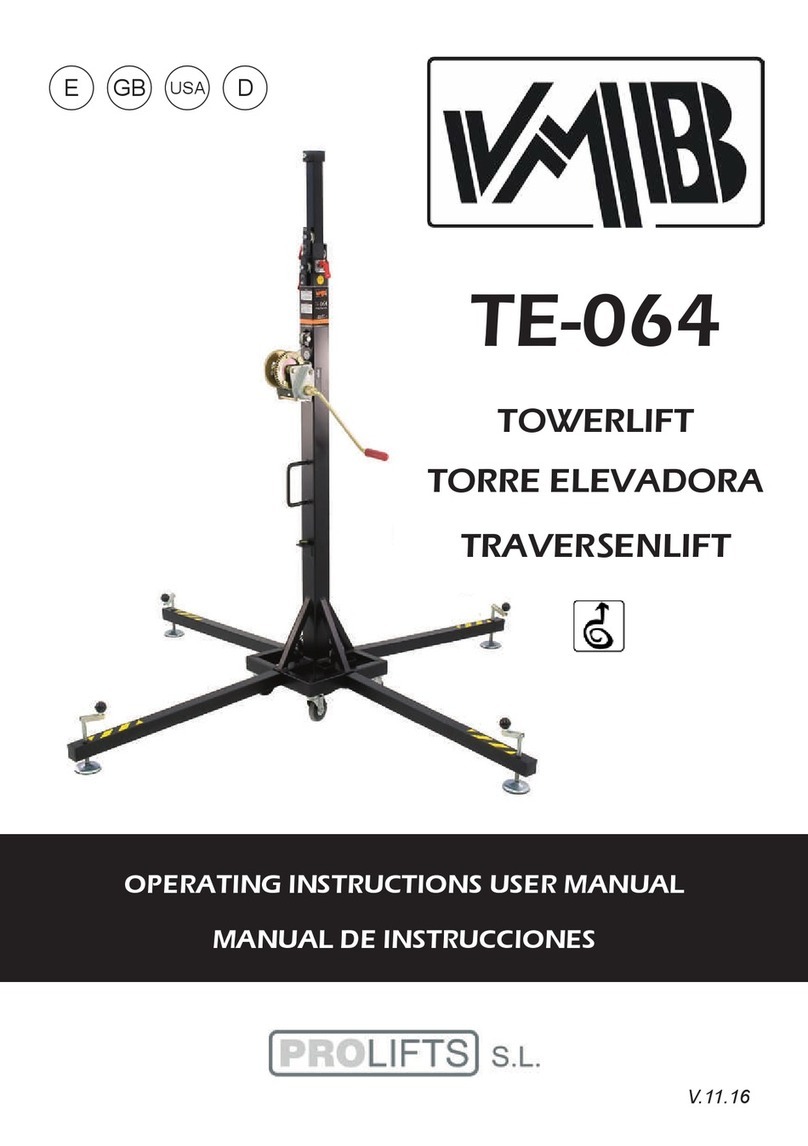
PRO LIFTS
PRO LIFTS VMB TE-064 Operating instructions & user manual
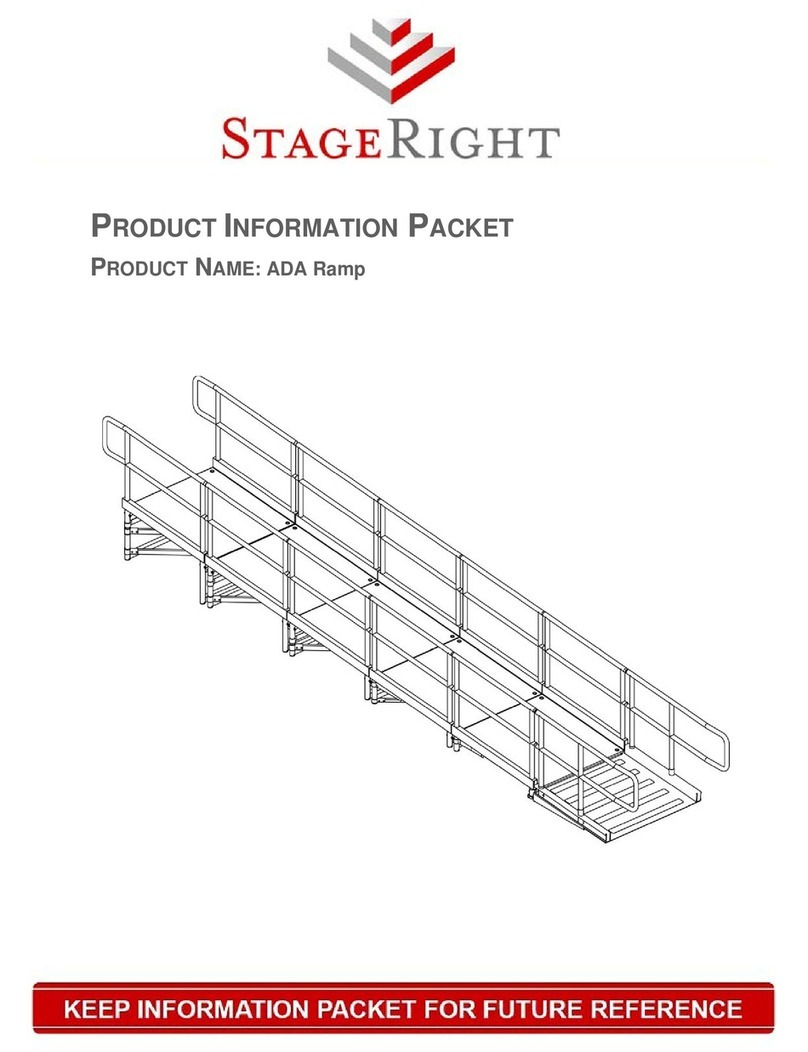
Stage right
Stage right ADA 350408 Product information packet

Hillrom
Hillrom Liko HygieneVest 50 Instruction guide

Bend-Pak
Bend-Pak HD-75BXT Installation and operation manual
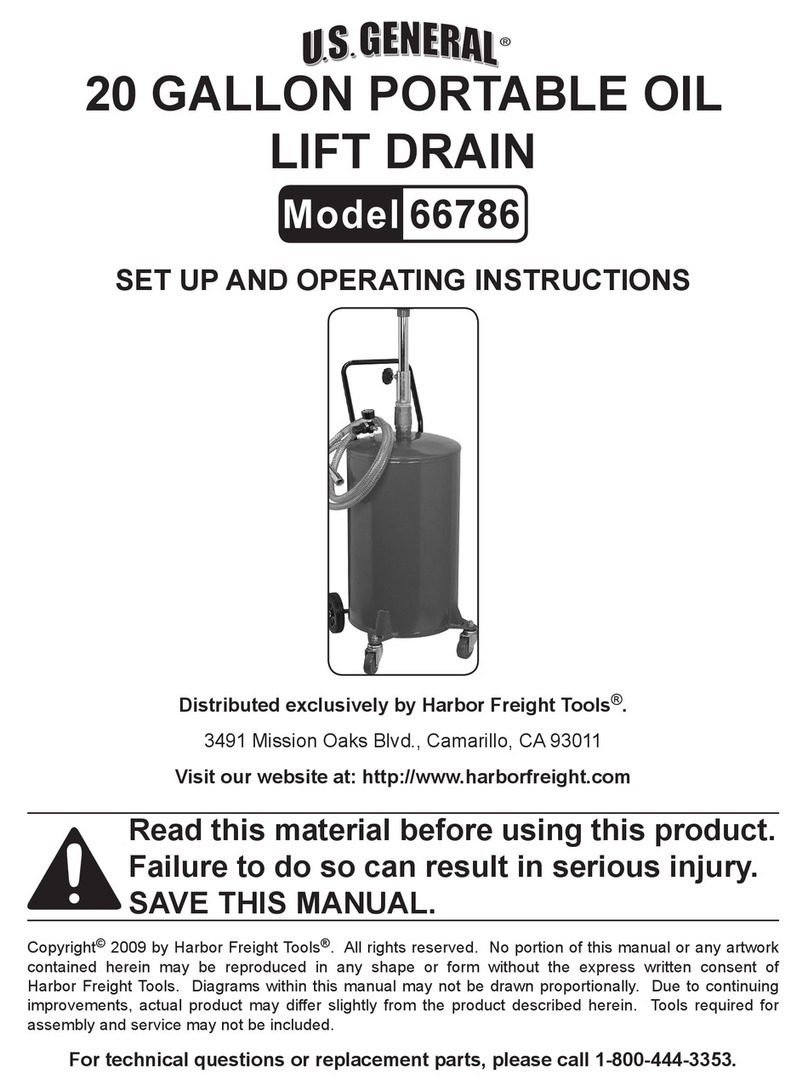
U.S. General
U.S. General 66786 Set up and operating instructions
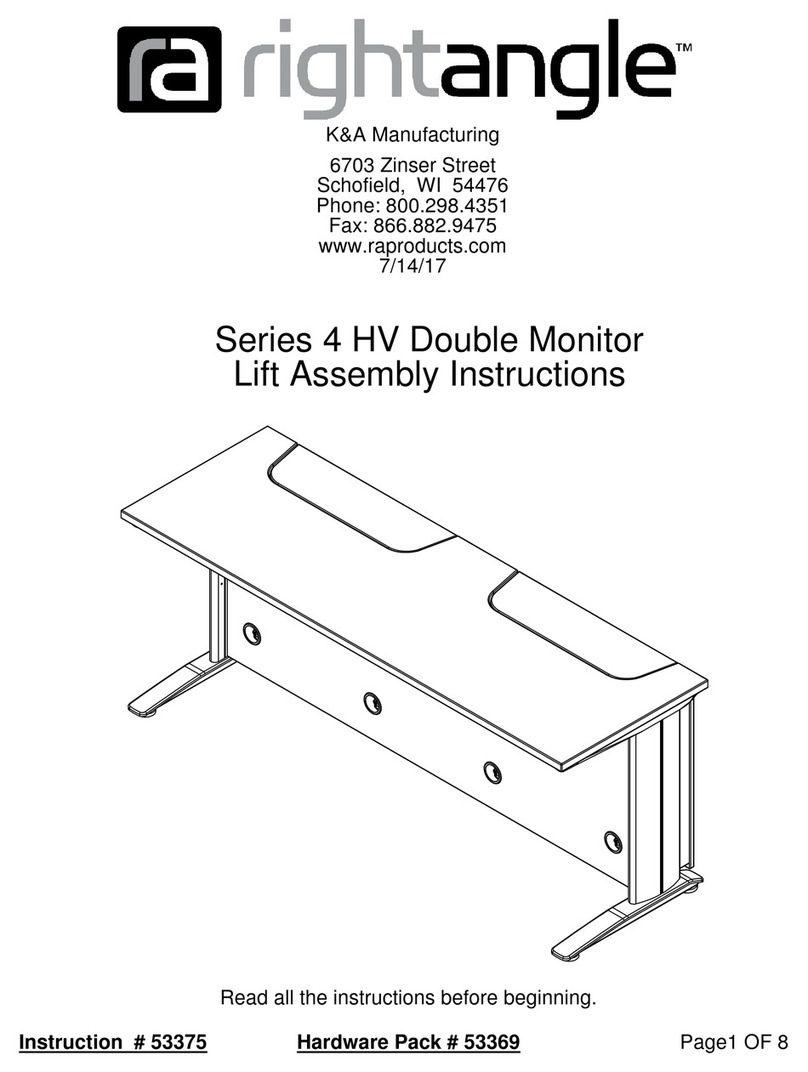
RIGHT ANGLE
RIGHT ANGLE 4 HV Series Assembly instructions


